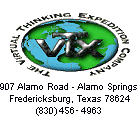 |
|
ABOUT US ON EXPEDITION! EXPEDITIONS RESOURCES E-MAIL US |
 |
 |
 |
 |
1997 = Diffferent = vTx
The Virtual Thinking Expedition Company
A Difffernt idea...Exploring the Unknown
on Adventures with the Mind
Houston. January 1, 1997. Rolf Smith, managing director of the Office of Strategic Innovation, inc. (OSI), a Texas corporation, today announced the formation of a new, diffferent, and separate division of the company called the Virtual Thinking Expedition Company (vTx). OSI will continue to focus on strategic innovation, creativity training, keynote presentations, conference workshops, and it's nine-year old School for Innovators. The strategic thrust of the Virtual Thinking Expedition Company will be on working with corporations and organizations in search of very different results for unusual and urgent large-scale complex problems.
Thinking diffferent to get different results is not new to OSI. Beginning in 1993, the firm tested Mini-Thinking Expeditions in a variety of formats over a wide range of routes and corporate problems in Australia, New Zealand, Texas, North Carolina, New York City, and the Colorado Rockies. They were amazingly successful in both team impact and bottom-line results. In 1994, in an on-going series of bold experiments built around significant real-world challenges facing such corporations as Exxon, Arco, British Petroleum, Hoechst Celanese and WMX Technologies, the idea of refocusing corporate project team thinking in very different ways was born.
Expeditions were organized around diverse teams - including customers, suppliers and outsiders - each with problems significantly different in scope and magnitude, yet all focused on very challenging cost reduction objectives: Alaskan Arctic Ice operations, manufacturing in the Carolinas and North Georgia, and oil and chemical plants on the Texas Gulf Coast. The results were startling and exciting when the teams achieved some "impossible" objectives with savings ranging from $2 Million to $50 Million.
By 1995 OSI had formalized the concept of the Thinking Expedition into a proven operational model and moved into the area of more complex and urgent large-scale issues. During 1995 and 1996, Thinking Expeditions explored new products, business development concepts, as well as softer and fuzzier areas in R&D. One Fortune 10 Expedition pushed into the unknowns of Human Resources, targeting $50 Million in savings over five years; conservative estimates now put the results at $130 Million. Attacking more complex problems, and working in concert with teams from companies such as Procter & Gamble, Exxon, Battelle National Laboratories General Mills, Johnson & Johnson, the U.S. Navy, Fletcher Challenge in New Zealand, and Cadillac Fairview in Canada, bottom-line results have piled up fast, easily exceeding $1 Billion in the last two years. In the process, new Thinking Expedition techniques, tools and processes have been cooperatively developed with the corporate project teams, both out of sheer necessity and as well as by building on the learnings on previous routes.
Perhaps the most important discovery though, according to Smith, has been a side effect: The clear impact Thinking Expeditions have had on the individuals in the teams involved, and correspondingly, on transforming a group into a real team. Team members leave the Expeditions with unusually high degrees of personal energy and individual commitment to thinking different in order to get different results. Smith believes that much of this comes from the atmosphere of adventure and risk, the deep feeling of actually being "on expedition" which the process inevitably creates. And with that, a cadre of highly energized, in-house Thinking Expedition guides is emerging, all graduates of the School for Innovators. Smith points out, however, that "I'm not sure I fully understand everything I know about this."
A prime example is the U.S. Navy SMART SHIP team, launched by Admiral Mike Boorda in late 1995, and kick-started by OSI through a series of Thinking Expeditions. Built around an operational warship, the USS YORKTOWN (CG-48), the results of the team's efforts in SMART shipboard manpower reductions alone have the promise of exceeding $1 Billion for Aegis class ships.
It is on this background that OSI has launched the Virtual Thinking Expedition Company. vTx, drawing on the network of in-house corporate expedition guides, will design, form and co-lead Thinking Expedition teams for corporations and organizations struggling to discover ways to get different results for urgent and critical problems and challenges. "Out-of-the-box and into the unknown is where corporations want to go today." says Smith, "We take them on exciting adventures with their minds through the 7 Levels of Change and the corresponding 7 Levels of Fear - and they bring back results. It works."
vTx has some ten Expedition Guides in its virtual basecamp, distributed across the United States and tied together over the Internet. Smith pulls 3-4 of the guides together into a lead rope team for each 'Thinking Expedition, selecting them based on the nature of the problem, the makeup and size of the corporate team, and the results and objectives around which the Thinking Expedition is to be organized. A typical Thinking Expedition takes a team of 16-36 people on a 3 or 4 day operation, each day running for 15-18 hours, the last day frequently ending well past midnight.
vTx will start the New Year off with a major Thinking Expedition for the U.S. Navy in the Washington area, immediately followed by a Strategic Thinking Expedition for the Electronic Messaging Association in San Diego. Both will be led by virtual rope team guides drawn from the vTx geographically distributed basecamp on the Internet.
Smith, a retired Air Force colonel, conceptualized and headed the first military office of innovation in 1986, and created a worldwide network of innovation centers in the intelligence community. After he left active duly, he created the Office of Strategic Innovation and worked with Exxon on their Innovation Initiative as a contract executive from 1991-1997. His new book, "The 7 Levels of Change" (Summit Publishing Group, 1997) details how to tie creativity, innovation, continuous improvement, and change together with correspondingly different levels of thinking.